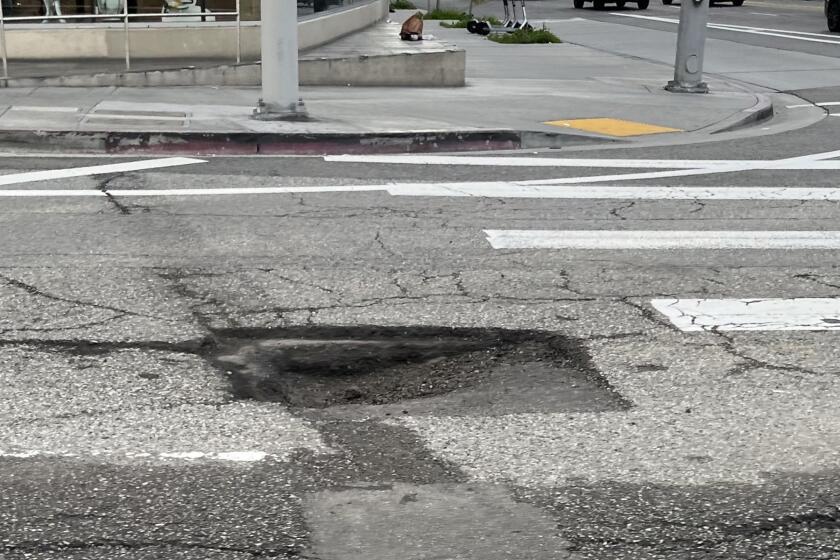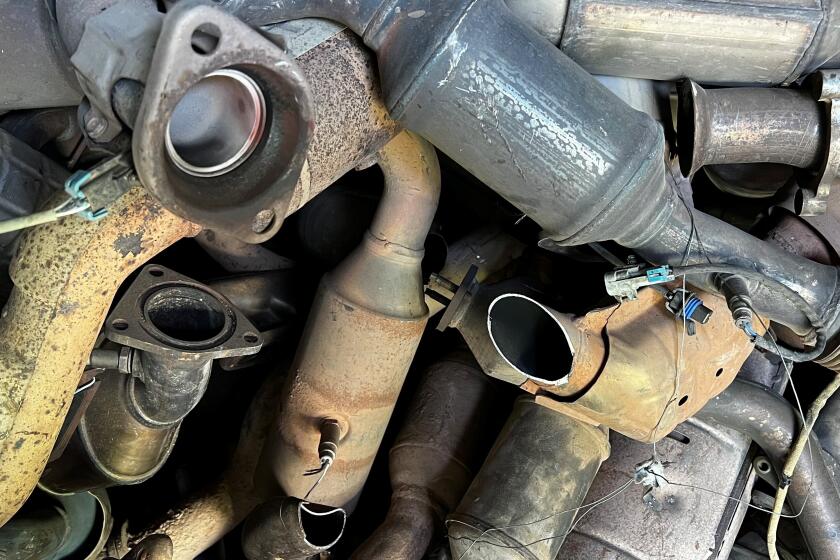With Pen and Attitude, Two Taggers Leave Their Mark
- Share via
“Excuse me,” I said.
The teen-ager eyed me casually for a moment and paused, palming a needle-sharp screw with which he’d been carving up the brown plastic bus seat.
He swung his leg aside, opening two of the three side-facing seats he’d occupied at the rear of the standing-room-only RTD bus.
Leaving one seat between us, I sat and checked him out: The ragged, sagging cut-off chinos, the tattoo on the web of his hand, the knot of hair atop an otherwise closely cropped head and other tell-tale signs suggested gangster.
But his demeanor, and his scrawling of one of those astonishingly ubiquitous three-letter abbreviations tagger crews use, indicated he was a step down in the hierarchy of what some euphemistically call “street organizations.”
Across the way, another younger but similarly attired boy grasped a chrome bar and pulled himself into the aisle. As the bus rumbled across Figueroa, they chatted and my seatmate calmly and repeatedly scratched his tag into the seat as if his motions were a complex subconscious tic.
The guy beside me hailed from Highland Park. The other came from the Valley. They knew each other and each others’ work because both range the bus lines, riding day and night to do what they do: graffiti.
They spoke with workman-like dispassion about painting freeway signs, railroad cars and buses, and talked about where to steal paint and markers. Now and then, one would gesture and ask about a particular tag visible on a farmacia sign or in a restaurant’s doorway: “You know him? He’s up all over.”
I delicately interrupted to ask a few questions. They answered politely and directly, filling me in on the complex alliances and animosities of the tagger crews and street gangs in the area near my home.
At first I wondered why they talked to me. Then, I realized: Adults don’t really matter much, barely even exist, in their world.
The moment I stopped talking, I became as invisible as other passengers.
*
Last year, the city of Los Angeles forked out an estimated $3.7 million to remove graffiti. The RTD spent more than three times as much--$13 million.
RTD bus windows tend to be so covered with gang and tagger chicken-scratch that it’s more annoying than distracting to watch the passing landscape.
The glass in this bus was still relatively pristine. As other passengers averted their gaze, they had a clean view of the toxic snail trail left by the legion of like-minded young men who hop from site to site on the RTD.
These wild-boy tribes have decorated virtually everything along the route--a bus bench, an on-ramp sign, billboards, murals, trees, utility boxes, mayoral candidates’ signs, the vast concrete canvas of the Los Angeles River and the smallest nub of curb.
They’ve splattered their tags on the stone facades of elegant old buildings and the plate glass of new strip mall stores, casting a spray-paint pall on shopkeepers’ entrepreneurial dreams.
The walls tell a story: As they grow mottled with coats of not-quite-matching paint, civic determination fades. Tumbleweeds and brittle litter cling to chain-link fences. Boards replace glass.
On this particular morning, as the bus edged into Chinatown, the taggers spotted an RTD security car at a stop. Suddenly alert, one calmly popped the catches on the emergency window behind me.
“I hate going out that way,” the other said, preparing to do just that. Grabbing the metal frame, he said, hurts his hands.
When the bus continued past the security car, the young men grew more ambitious.
“Got a Mean Streak?” my seatmate asked.
The Valley youth drew a fat-tipped indelible blue pen from his pocket and handed it over.
With no more concern than if he were doing a crossword puzzle, my seatmate turned and wrote his crew’s tag across the window in foot-high letters. Over and over he signed his crew’s tag and his own, covering the window, the seat and the walls with sweeping blue lines.
The pen’s owner grinned, impressed with his colleague’s bravado. When he got the pen back, he added his tag to the illegible scrawl.
A couple days after this ride, a 77-year-old passenger in the Valley would make a citizen’s arrest on two taggers, becoming an instant folk hero to some.
On this bus, however, none of the passengers tangled with these taggers. The day had barely begun and already they were worn out from watching this in-your-face display of the city’s decline.
*
For me, riding the bus a few times a month is a change of pace or a convenience when my car is in the shop. Most folks on Line 83 don’t have my options.
As I watched the young men’s spree, my reporter’s detached curiosity diluted my anger as a taxpayer and passenger.
Other faces on this bus--a mosaic as ethnically diverse as the city--revealed more intense emotions.
A young African-American mother with two toddler daughters stared at the taggers with a learned neutral gaze that failed to conceal a simmering anger. An old Asian man remained standing, clearly frightened by their raw aggression.
The face that most stuck in my mind, though, belonged to a husky Latino in his late 30s, who probably could have flung the taggers off the bus with a flick of his wrist. This guy looked like he had paid some dues and had probably earned the right not to be pestered by street punks. But the ring of keys jangling on his belt and his scuffed boots suggested that he had a job to get to. So he scowled out the window and quietly endured this overt gesture of disrespect.
Maybe I’m projecting how I’d feel if I were condemned to spend each morning and evening amid this visual cacophony. But I think those taggers scratched not only at the city’s increasingly thin facade of civility--they scratched at one man’s belief he could control his own small slice of life. They eroded what little peace of mind he’d earned, and left scars on his self-respect.
Whenever the subject of graffiti comes up, some tenured activists or pseudo-streetwise commentators, who have somehow purchased an exemption from the scorn of the bullies they abstractly embrace, are guaranteed to pipe up. They invariably whine about the hopelessness of Los Angeles’ youth.
On the bus that morning I saw the growing hopelessness of hard-working adults.
Last year, one such TV commentator said young people are sending messages to society with their spray paint. Instead of getting upset about graffiti, he said, adults should learn to listen.
His smug tone made me shout back at the television screen: What happened to the days when things were the other way around? When adults had the strength and courage and commitment to send messages to the children?
But as I got off the bus that morning, I realized that in one sense the commentator was right. My seatmate and his friend were sending a message: Nobody cares enough about us to make us behave.
More to Read
Sign up for Essential California
The most important California stories and recommendations in your inbox every morning.
You may occasionally receive promotional content from the Los Angeles Times.










